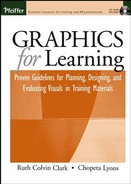In Section Two, we looked at evidence-based guidelines for ways to plan and design visuals that support the psychological processes leading to learning. In this section we shift our focus to your lesson content. Drawing on the work of M. David Merrill and Robert Horn, Clark (2000) has summarized the best instructional methods to teach five basic content types found in organizational training. The five content types are procedures, concepts, facts, processes, and principles. In this section we focus specifically on best ways to visualize these content types.
As discussed in Chapter Two, when you apply a systematic graphics design model, one of your first activities is to define the instructional goals. Most lessons have one or two of the following goals: to inform, to help workers perform procedural (near transfer) tasks, and to help workers apply guidelines to perform principle-based (far transfer) tasks. Lessons developed to build job skills usually fall into one of the last two categories. Thus procedural lessons will teach steps to perform routine tasks while principle-based lessons will teach guidelines. To apply procedures or guidelines, the worker must understand related facts and concepts. In addition, any workers involved in repairing, managing, or optimizing systems will profit from process knowledge.
For example, if you are developing training on how to use a software package to create Web pages, the core of your instruction will be procedures to illustrate how to implement the steps to accomplish tasks. Along the way, various concepts and facts will be needed. For instance, if you are learning to use the software to set page properties, youwill need toknow what page properties are and which page properties to use for specific purposes.
You will define the specific content types for your lessons during your job analysis. Through interviews and observations of experienced workers, you identify the tasks and the associated knowledge needed to perform those tasks. Once you define your content, you can consider how to visualize them in the context of the full instructional landscape. For more information on how to derive the content types during the job analysis process, see Clark (2000).
Even the best illustration for a given content type will do little good if it is ignored. Research has proven that learners who take the time to study and process visuals profit from them (Gyselinck and Tardieu, 1999; Schnotz, Picard, and Hron, 1993). It is important that you go beyond providing the best visuals for each content type to also promote learner engagement with your visuals. Therefore, each chapter includes not only the best visuals to display specific content but also ways to promote engagement with those visuals.
After training (or sometimes in lieu of training) workers will need memory support on the job. Commonly known as performance aids or job aids, performance help can also benefit from visuals. We discuss design of performance aids in this section especially in Chapter Eleven on procedures and Chapter Thirteen on facts.
Although this section treats each content type individually, you will see in Section Four how all the diverse content types that make up a lesson are visualized and integrated into a unified instructional product.
Table I3.1. An Overview of Chapters Eleven-Fifteen.
Chapter | How to Visualize | Shows How To |
|---|---|---|
11 | Procedures | Use transformational visuals to illustrate the steps the learner takes to perform a procedural task. Emphasizes how to support transfer of learning and manage cognitive load. |
12 | Concepts | Use visuals to help learners build mental models of concepts that will enable them to make discriminations on the job. |
13 | Facts | Use representational and organizational visuals to illustrate concrete and discrete factual information. Emphasizes the design and placement of memory aids to help workers retrieve facts when needed. |
14 | Processes | Use transformational visuals that incorporate representational visuals for concrete processes and analogical visuals for abstract processes to help workers build mental models of how systems work. |
15 | Principles | Visualize guided-discovery lesson architectures to support problem-centered learning as well as how to use interpretive visuals to display scientific principles. |
CHAPTER OUTLINE

What Are Procedures?
Teaching Procedures
Performance Aids for By-Passing Training
How to Visualize Procedures
Guideline 1: Provide Demonstrations That Combine Transformational and Representational Visuals
Guideline 2: Design Transformational Visuals That Show Activity Flows from the Performers' Perspective in the Work Environment
Show Actions in Context
Use Transformational Visuals that Show Action Flows in Manuals
Guideline 3: Manage Cognitive Load for Complex Procedures, Novice Learners, and Instructionally Paced Materials
Use Visual Cues to Direct Attention
Provide Memory Support for Use During and After Training
Use Audio to Explain Animated Demonstrations
Place Text Close to the Visuals It Describes
Use Diagrams to Illustrate Instructions that Involve Spatial Complexity
Eliminate Extraneous Detail
Guideline 4: Use Visuals to Draw Attention to and Illustrate Warnings
Guideline 5: For Online Practice of Computer Procedures, Support Transformational Visuals with Onscreen Contiguous Text for Directions, Feedback, and Memory Support
Visualization of Feedback During Simulations
Memory Support
Tips for Visualizing Procedures
Common Mistakes to Avoid When Visualizing Procedures
